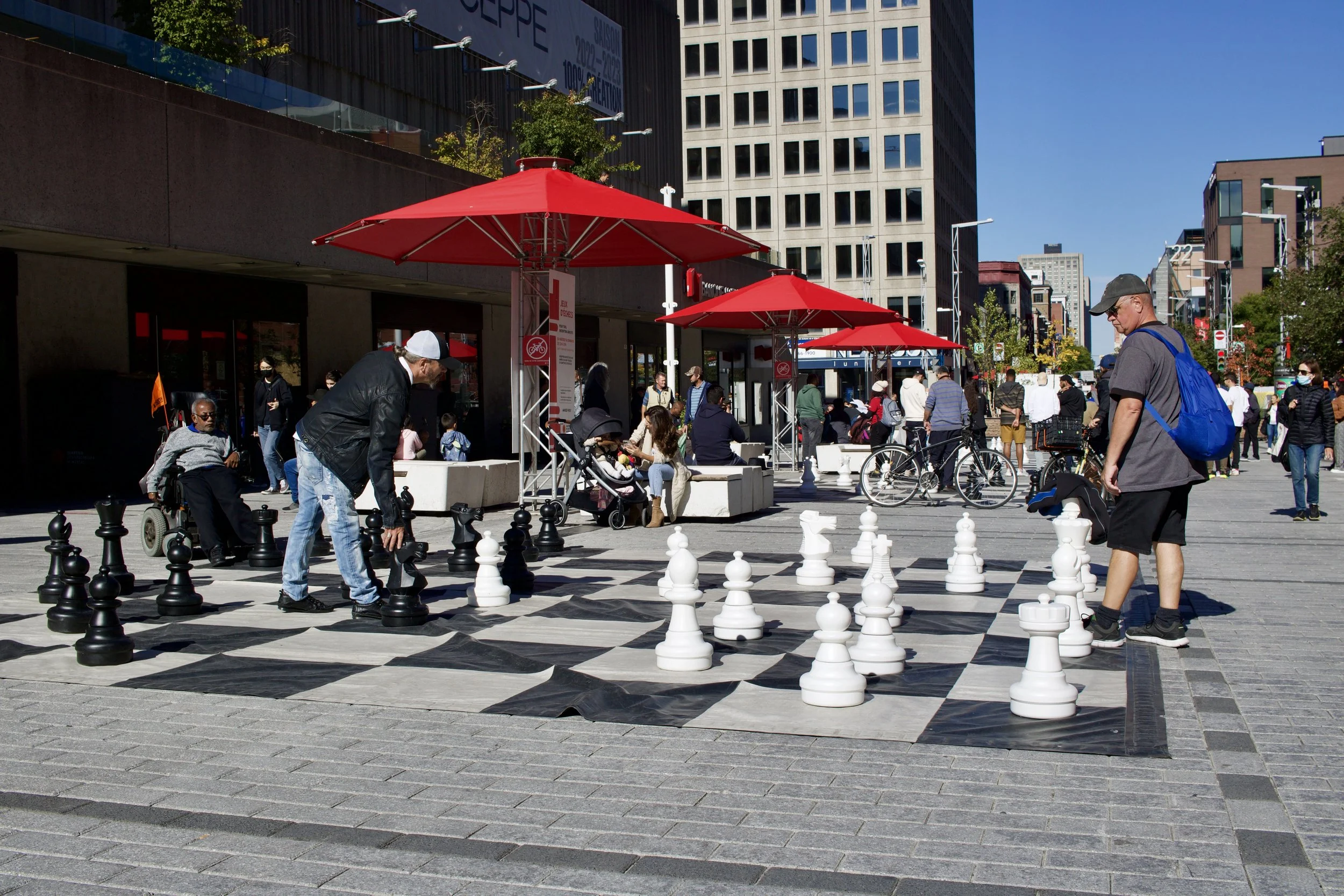Planning’s Boys’ Club: Alive, Adapted, and Still Holding Power
Two men playing chess in a public square in Montreal. Photo taken by Nicole Roach.
Urban planning today often presents itself as progressive, portraying itself as the architect of inclusive cities. While we take pride in these claims, there is also a sense of embarrassment beneath the surface. How can we claim to design equity for others when we have not even addressed the inequities in our own house? Though we don’t always say it out loud, the reality is clear: the old boys’ club still exists, and the weight of history remains present at the table.
A Profession Built by Men
Urban planning was almost entirely developed by men; they founded the institutions, wrote the theories, and defined what counted as “expertise.” From Howard’s Garden Cities to Burnham, Le Corbusier, and Moses, the canon was dominated by male, white urbanists, and rooted in assumptions that excluded everyone outside a narrow, male, white, Western elite.
Even as women entered the field, we inherited a legacy that involved being trained on male-authored texts and being judged by masculine codes of leadership. As Iris Marion Young (1990) reminds us, oppression is not just exclusion but the dominance of norms that pass as universal. This forms the underlying structure of the “boys’ club”; embedded not only in who sits at the table, but in the architecture of the profession itself.
The Survey Speaks
The concept of a boys' club within the planning profession wasn’t new to me. I had experienced it firsthand, sat through it, and overheard whispers about it in hallways, like bad office gossip. The thing is, those whispers weren’t just rumors; they were survival tips. I aimed to bring this ‘common sense’ into the daylight and show it for what it is: not an occasional annoyance, but a pattern built into the profession itself.
To gather insights, I conducted a survey through my LinkedIn and asked my network to share it. The responses came from women and non-binary professionals across various provinces and career stages. While it was not a scientific sample, it held credibility as it reached professionals directly engaged in planning practice, and their stories echoed each other with striking consistency.
The message was clear and fell into three major patterns:
Prevalence of bias: More than 70% reported experiencing gender bias in their careers.
Being ignored: Over half stated that their ideas were dismissed until repeated by a man.
Proving oneself: Many described the necessity of working twice as hard just to be seen as equally competent.
Emotional impact: The most common words used were “frustrated”, “undervalued”, “dismissed”, “angry”, and “tired.”
Word cloud from the survey.
Not everyone shared this perspective. Roughly 30% of respondents said they hadn’t experienced bias directly, or believed that conditions were improving - especially in larger cities or among younger colleagues. These insights matter too, because they suggest progress is possible. Unfortunately, the consistency of the majority’s experiences makes the overall pattern impossible to ignore.
I included open-ended questions because personal stories matter as much as statistical data. Their words highlighted the pattern:
“Women need to prove themselves while men are perceived as capable until proven otherwise.”
“I gave input in a meeting and it was dismissed. Minutes later, a man repeated it, and suddenly it was valuable.”
“I was asked to take notes in meetings even though I was the most senior professional in the room.”
“A council member once told me he liked me better in a skirt.”
“I felt invisible - until I made a mistake, and then suddenly I was visible in the worst way.”
Woman sitting on a chair in front of a desk with a desktop. Photo by Christina @ wocintechchat.com on Unsplash.
The boys’ club hasn’t vanished — even in the 21st century. Of course, it no longer excludes women outright, but it retains men in default positions of trust and leadership, while women and non-binary professionals must constantly re-earn their legitimacy. The impact isn’t one dramatic instance of exclusion you can point at and report, but a steady accumulation of small barriers — the thousand daily cuts that erode confidence and stall careers.
Beyond the Numbers
Planning offices may look more diverse, with HR promoting equity, and women filling seats, yet many still feel frustrated, undervalued, or invisible. Representation alone does not dismantle structures. The behaviours reported in the survey - being ignored, proving oneself twice over, harsher judgment for mistakes - reflect deeper norms. Planning was built within male-dominated institutions, shaped by male-authored theories, and reinforced by masculine codes of leadership. While more diverse individuals may enter the profession, the rules of credibility, trust, and authority remain skewed.
As one respondent put it:
“HR talks about inclusive workplaces but does not follow through. Complaints are ignored. The blame always falls on the victim.”
Another echoed:
“Policies exist, but they are useless decorations.”
The survey shows that the boys’ club operates through unspoken rules: men are trusted with major projects, are forgiven for failure, and promoted through informal networks. Assertiveness and constant availability are rewarded, while women who lead differently are unfairly judged as weak or “not ready.” Even worse — when women are assertive, they are often labeled as bossy or rude. And even in workplaces where women are the majority, these subtle biases still skew power dynamics.
Not the Same Everywhere
The landscape is uneven. In big cities like Toronto, Vancouver, and Montreal, women may fill entire departments. However, in smaller municipalities, suburbs, and rural offices, they are often the lone voice, sidelined and isolated. The “boys’ club” manifests differently depending on location - subtle in some places, more overt in others. A minority of respondents reported not facing bias and saw progress, especially with younger colleagues.
When Bias Piles Up
For many, gender bias was only the first layer of discrimination. Immigrant women were judged by their accents instead of their expertise. Muslim planners heard their hijab be called “distracting” or “unprofessional.” Some women of colour reported pay gaps up to 20%, and when they spoke up, they lost responsibilities instead of gaining fairness. Non-binary professionals said their leadership was treated as a novelty, and queer respondents saw authority still measured against white, straight, male norms.
As one respondent put it:
“My accent was louder than my credentials.”
Another said:
“Fairness stops where the comfort of my white male colleague begins.”
This isn’t just sexism. It’s sexism intertwined with racism, nativism, homophobia, and ableism. It doesn’t protect all men, just a specific type: the right colour, the right passport, the right body type, and the right sexual orientation. For everyone else? They’re lucky if they get a guest pass!
A group of men socialize in a public space in Amsterdam. Photo taken by Nicole Roach.
My Scars, Their Patterns
My career has not been free of bias. I’ve had clients ask for a “real planner” instead of “this girl,” and senior managers have called me a “good girl,” doubted my judgment, and labelled me “bossy” when I asserted myself. These weren’t isolated incidents - they showed how authority in planning is still coded by gender.
However, not every workplace feels the same. Some women and non-binary professionals report greater ease: their voices heard, their expertise trusted, and their authority less questioned. Rosabeth Moss Kanter showed in Men and Women of the Corporation (1977) that legitimacy grows when homogeneity is disrupted, and that “critical mass” helps women move beyond tokenism. Leslie Kern (Feminist City, 2019) notes that younger generations breathe feminist ideas as common sense, and Leonie Sandercock (Making the Invisible Visible, 1998) argued that feminist and multicultural frameworks can redefine who counts as an expert.
Not all men act alike, either. Pierre Bourdieu called this habitus - norms carried into practice that shape “perceptions, appreciations, and actions.” Michael Kimmel (Angry White Men, 2013) observed that some men see women’s gains as their loss, while bell hooks (The Will to Change, 2004) reminded us that patriarchy “has no gender”: it harms men too, but rewards them, which is why many refuse to let it go.
This is why workplace cultures remain so uneven. While cultures can shift, critical mass can matter, and some individuals can unlearn entitlement - the “boys’ club” adapts rather than disappears where masculine norms remain unchallenged.
Cities Mirror Power
What I am trying to say isn't just about workplace fairness - it’s about the cities we build. When women and non-binary professionals are sidelined, their absence shows up in transit designed for the “ideal” male worker, parks without safety in mind, and housing blind to the double shift of care and paid labour. As Dolores Hayden (The Grand Domestic Revolution, 1981) showed, the built environment encodes the values of its makers.
COVID-19 cracked this open: flexibility, once dismissed as a women’s issue, became urgent for everyone.Heejung Chung and colleagues (2021) found men too felt the strain of balancing care and work. What feminists argued for decades was suddenly undeniable: these aren’t marginal concerns but structural ones!
Woman standing on the stairway during daytime. Photo by Anna Sullivan on Unsplash.
Care Isn’t Just Women’s Work
Too often, care in planning is still coded as women’s work. This framing not only misses reality, it risks reinforcing the very stereotypes we’re trying to undo. As Nancy Fraser (After the Family Wage, 1994) argued, justice requires a “universal caregiver model” - caregiving as a shared human responsibility, not a woman’s burden. Fathers on paternity leave, single dads, and non-binary parents all navigate systems that still assume “mother” is the default. Andrea Doucet (Do Men Mother?, 2006) showed men can and do provide care, but institutions rarely recognize it.
And care is only one piece. Missing representation of women in planning also means missing issues of safety in public space, mobility patterns that reflect lived routines, housing that fits diverse households, decision-making power, and the recognition of knowledge as expertise. Without women and non-binary perspectives, cities reproduce only part of human experience - the part historically defined by men.
Policies with No Teeth
The “boys’ club” won’t collapse under the weight of another glossy policy PDF!
In the survey, over half of participants said current equity policies feel “fake,” like “window dressing,” or mere “decoration.” Some acknowledged that these policies can help - by setting expectations, creating shared language, or offering support such as parental or caregiving leave. But nearly everyone agreed: without structural change, such policies remain flimsy.
Respondents pointed to the same core shifts again and again:
Redistribute trust - stop assuming competence is male by default.
Sponsor across difference - track who gets the big files and high-profile promotions.
Change the culture of failure - give women and non-binary staff the same right to stumble and recover.
Value different leadership codes - collaboration and care should count as much as aggression and swagger.
Make policies accountable - equity without consequences is decoration.
As one respondent put it, “Policies exist, but they’re just paper. Nothing changes until culture changes.”
Scholars say the same. Leonie Sandercock (2003) urged inclusion beyond formal rules; Joan Acker (1990) showed inequality is built into the very structure of organizations; Iris Marion Young (1990) warned that “difference-blind” norms only reproduce dominance; and Dolores Hayden (1981) demonstrated that even cities themselves encode patriarchal values when structures go unchallenged.
Policies may open doors. But unless they come with accountability and new definitions of leadership, the boys’ club will keep the keys.
The Work Ahead
The “boys’ club” is not going to hand in its resignation! If it’s going to fall, it will take all of us: men and women, white and racialized, queer and straight, able-bodied and disabled, religious and not, students, junior planners and senior managers. Wherever you sit, there is work to do:
If you’re just starting out: Don’t mistake silence for survival. Speak up when credit is stolen, and don’t laugh off the “jokes.” You don’t owe the club complicity.
If you’re mid-career: Notice who gets invited into networks, and who is left out. Share contacts, mentor across differences, and stop joining panels or projects that look like a mirror room - where everyone is a reflection of the same privilege and perspective.
If you’re in leadership, pay attention: count who gets the raises, the promotions, the flagship projects. If the numbers tilt toward men, white staff, or straight colleagues - question them. Look closer. Reward collaboration, care, and humility with the same enthusiasm you reward “confidence.
If you’re a man: Don’t just clap from the sidelines. Step back when your presence dominates. Sponsor women and non-binary colleagues for stretch roles. Challenge other men when they slip into the comfort of the club.
If you hold privilege of any kind, whether it’s gender, race, class, ability, or position: Use it. Call out bias. Share the mic. Make space. Privilege wasted is privilege protecting the status quo.
Only together can we break the club and build the room we all deserve.
Resources
Literature
Acker, J. (1990). Hierarchies, Jobs, Bodies: A Theory of Gendered Organizations. Gender & Society, 4(2), 139–158. https://journals.sagepub.com/doi/abs/10.1177/089124390004002002
Bourdieu, P. (1977). Outline of a Theory of Practice. Cambridge University Press. https://www.taylorfrancis.com/chapters/edit/10.4324/9781003060963-11/outline-theory-practice-pierre-bourdieu
Chung, H., et al. (2021). Research on COVID-19, work–life balance, and care responsibilities. https://journals.sagepub.com/doi/full/10.1177/08912432211001304
Connell, R. W. (1995). Masculinities. University of California Press. https://www.taylorfrancis.com/books/mono/10.4324/9781003116479/masculinities-rw-connell
Doucet, A. (2006). Do Men Mother?. University of Toronto Press. https://utppublishing.com/doi/book/10.3138/9781487520519
Fraser, N. (1994). After the Family Wage: Gender Equity and the Welfare State. Political Theory, 22(4), 591–618. https://journals.sagepub.com/doi/abs/10.1177/0090591794022004003
Hayden, D. (1981). The Grand Domestic Revolution: A History of Feminist Designs for American Homes, Neighborhoods, and Cities. MIT Press. https://mitpress.mit.edu/9780262580557/the-grand-domestic-revolution/
hooks, b. (2004). The Will to Change: Men, Masculinity, and Love. Atria Books. https://bellhooksbooks.com/product/the-will-to-change/
Kanter, R. M. (1977). Men and Women of the Corporation. Basic Books. https://www.hbs.edu/faculty/Pages/item.aspx?num=10807
Kern, L. (2019). Feminist City: Claiming Space in a Man-Made World. Verso. https://www.versobooks.com/en-ca/products/2626-feminist-city?srsltid=AfmBOoq4FUZxdQDeZm7rBy4LSXUKMZkPiY5jxQ73Tdx7SLeg_cytEiN6
Kimmel, M. (2013). Angry White Men: American Masculinity at the End of an Era. Nation Books. https://www.amazon.ca/Angry-White-Men-American-Masculinity/dp/1568589611
Sandercock, L. (1998). Making the Invisible Visible: A Multicultural Planning History. University of California Press. https://www.ucpress.edu/books/making-the-invisible-visible/paper
Sandercock, L. (2003). Cosmopolis II: Mongrel Cities in the 21st Century. Continuum. https://www.bloomsbury.com/ca/cosmopolis-ii-9780826464637/
Young, I. M. (1990). Justice and the Politics of Difference. Princeton University Press. https://press.princeton.edu/books/paperback/9780691235165/justice-and-the-politics-of-difference?srsltid=AfmBOopD9e4UoFLfnjCgsMGyuDq7lzQmgiw5NPX8ZOh7HeVyVr6-Ni41






